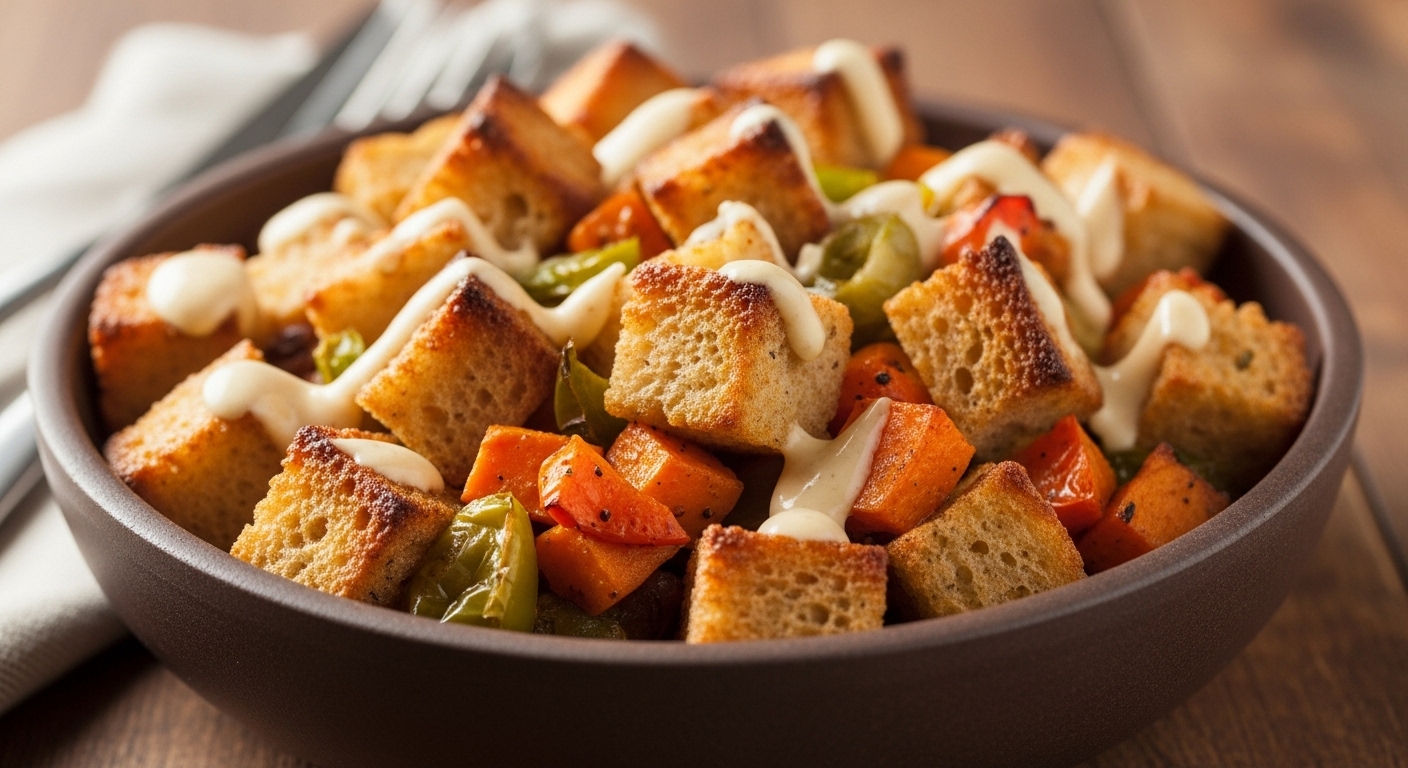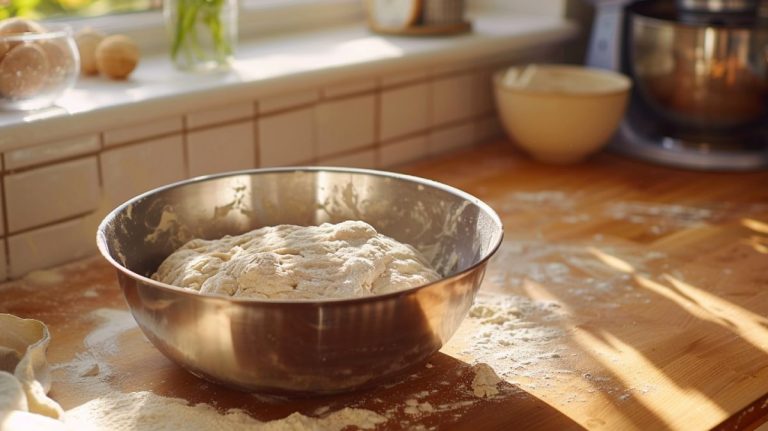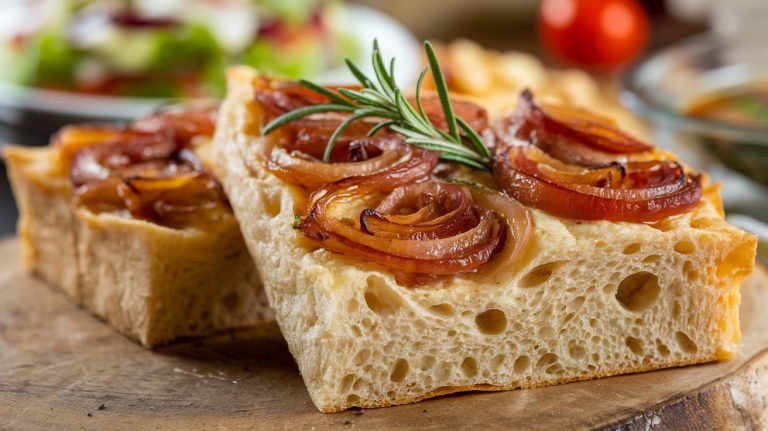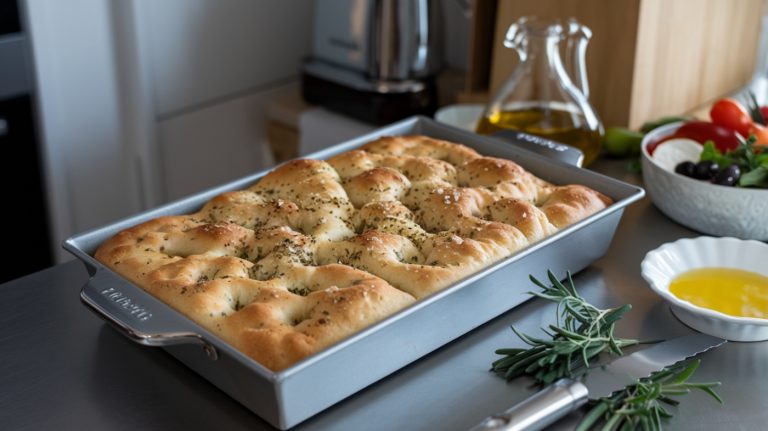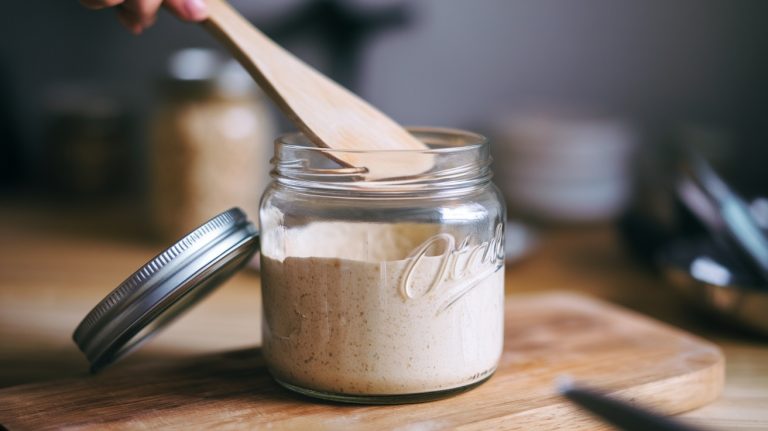Sourdough Stuffing Recipe: Quietly Stealing Spotlights
Sourdough stuffing transforms ordinary holiday sides into something extraordinary. This tangy, crusty bread creates the perfect foundation for a stuffing that quietly steals the spotlight at any gathering. Unlike traditional stuffing that can turn mushy, sourdough’s unique fermentation and open crumb structure deliver incredible texture and depth of flavor.
You’ll discover the secret techniques that professional bakers use—from properly toasting bread cubes at 300°F to achieving that perfect moist-but-not-soggy balance. Learn why day-old sourdough outperforms fresh bread, master the art of sautéing vegetables for maximum flavor, and unlock the timing tricks that ensure a golden, crispy top every time.
This isn’t just another stuffing recipe—it’s your guide to creating a show-stopping side dish that guests will remember long after the meal ends.
Key Takeaways
- Use day-old sourdough bread cut into 1-inch cubes and toasted at 300°F for 20-30 minutes to ensure crisp texture.
- Sauté chopped carrots, onions, celery, and herbs until tender, adding garlic near the end for enhanced flavor.
- Combine toasted bread cubes with sautéed vegetables, then gently mix in seasoned egg and broth mixture for moist stuffing.
- Bake stuffing covered at 350°F for 40-45 minutes, uncovering for the last 10-15 minutes to achieve a crispy top.
- Let stuffing rest 10-15 minutes after baking to meld flavors and set the perfect texture before serving.
Complete Sourdough Stuffing Recipe Table
| Ingredients | Process |
|---|---|
| 1 loaf day-old sourdough bread, cut into 1-inch cubes | Cut bread into uniform cubes and toast at 300°F for 20-30 minutes until crisp |
| 2 tablespoons olive oil or butter | Heat in large skillet over medium-high heat |
| 1 medium onion, chopped | Add to heated oil and sauté for 6-8 minutes until translucent |
| 2 medium carrots, chopped | Add with onions and cook until tender |
| 2-3 celery stalks, chopped | Add with carrots and onions, stirring occasionally |
| 3 cloves garlic, minced | Add near end of vegetable cooking time |
| 1 tablespoon fresh sage, chopped | Add with garlic and cook for 1-2 minutes |
| 1 teaspoon fresh rosemary, chopped | Add with other herbs to preserve aroma |
| 1 teaspoon fresh thyme | Combine with other herbs |
| ¼ cup fresh parsley, chopped | Add for color and fresh flavor |
| Salt and pepper to taste | Season vegetables throughout cooking |
| 2 eggs, beaten | Whisk together with broth |
| 2 cups chicken or vegetable broth | Combine with beaten eggs and seasonings |
| ¼ cup butter, cubed | Dot over stuffing before baking |
Preparing the Sourdough Bread
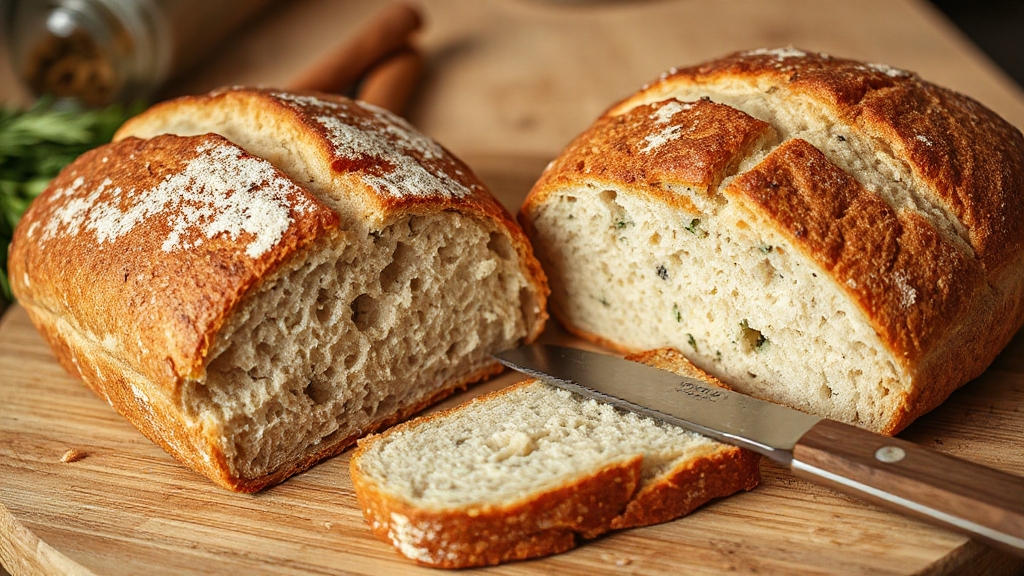
When preparing sourdough bread for stuffing, start by choosing day-old or slightly stale bread, as fresher loaves tend to become too mushy during cooking. Select a sourdough loaf with an open crumb and chewy crust to absorb flavors while maintaining structure. This is because sourdough bread is known for its chewy texture and crisp crust, which help it hold up well in stuffing.
Cut the bread into roughly 1-inch cubes to ensure even toasting and proper absorption of broth. Spread the cubes on a baking sheet and toast them in a 300°F (150°C) oven for 20-30 minutes, stirring occasionally.
Toast until the cubes are dry and crisp but avoid browning to prevent bitterness. Once toasted, let the bread cubes cool completely before mixing them into your stuffing mixture.
This step prevents premature sogginess and helps maintain the ideal texture in your sourdough stuffing.
Sautéing the Vegetables and Herbs
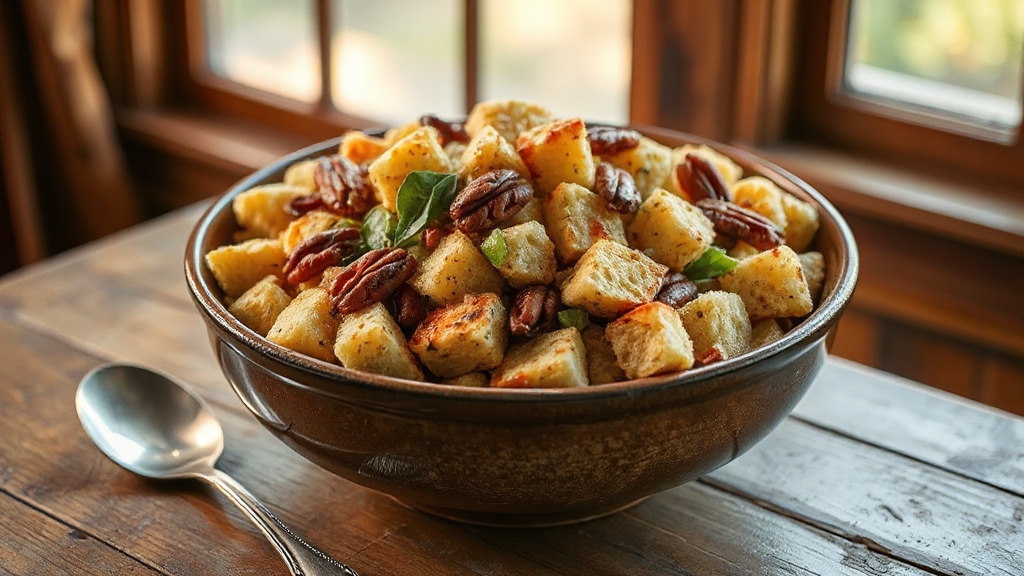
Although prepping vegetables can feel tedious, sautéing them properly is key to building flavor in your sourdough stuffing. Begin by chopping carrots, onions, and celery into uniform pieces for even cooking.
Heat olive oil or butter in a large skillet over medium-high heat. Add these hardy vegetables first, stirring occasionally to prevent sticking. If needed, add a splash of water, cover, and steam to soften before browning.
To achieve the best results, preheat the pan and add oil together, waiting until the oil shimmers or just begins to smoke before adding the vegetables to ensure even cooking and prevent sticking preheat the pan. Using whole grain flours in your sourdough can enhance the overall flavor profile of the stuffing.
Start by heating oil or butter, then cook hardy vegetables gently, adding water and covering if they need softening before browning.
After 6–8 minutes, toss in softer vegetables like bell peppers and zucchini. Season with salt and pepper throughout.
Add garlic and fresh herbs such as thyme or tarragon near the end to preserve their aroma. Avoid overcrowding the pan to ensure browning, not steaming.
Once vegetables are tender and lightly browned, remove from heat and let cool before mixing with your bread.
Mixing the Stuffing Ingredients
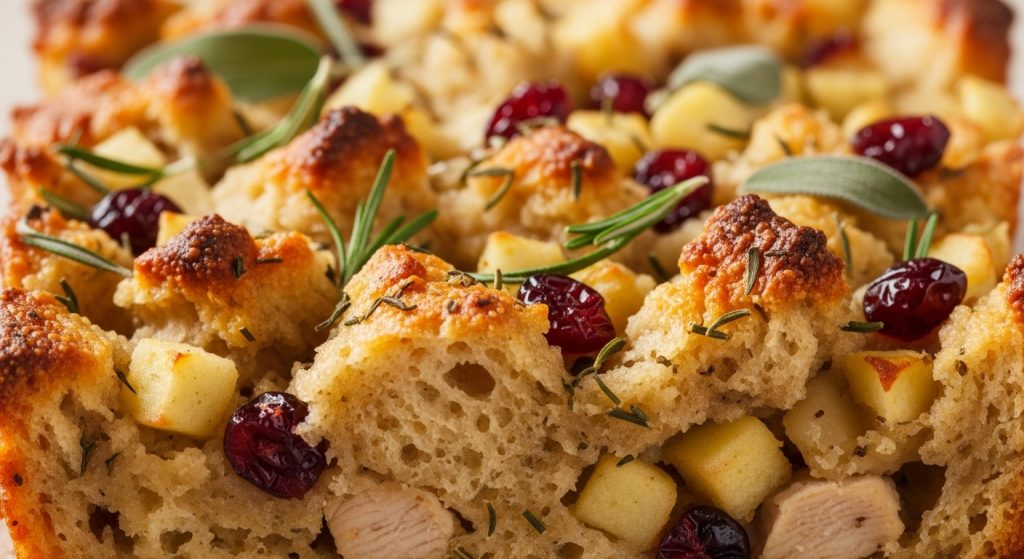
Once your sautéed vegetables and herbs have cooled, you’re ready to combine them with the dried sourdough bread cubes. Place the 1-inch bread cubes in a large bowl to allow room for gentle tossing.
Add the vegetables and herbs, folding carefully to coat the bread evenly without crushing it. Next, whisk together eggs and broth, seasoning with salt and pepper, then slowly pour this mixture over the bread and vegetable blend. Toss gently to distribute moisture uniformly—aim for a balance where the bread is moist but not soggy.
Check by squeezing a handful; it should hold together but feel airy. Using sourdough bread as the base enhances the stuffing’s flavor and texture due to its fermentation benefits. The natural fermentation process of sourdough bread can also lower the glycemic index, making it a health-conscious choice for your stuffing recipe.
Proper mixing ensures the stuffing’s texture stays light and cohesive, setting you up perfectly for the next step without compromising flavor or structure.
Baking the Stuffing
To bake your sourdough stuffing perfectly, preheat your oven to 350°F and grease a 9×13-inch baking dish with butter to prevent sticking and add flavor. Using a baking dish like this helps ensure even heat distribution for optimal cooking.
Spread the stuffing evenly in the dish, then dot the top with small butter pieces for enhanced browning. Proper drying of the bread cubes before mixing is crucial to prevent sogginess in the final dish, ensuring a desirable texture.
Evenly spread the stuffing and dot with butter for a beautifully browned, flavorful top.
Cover the dish with foil to trap moisture and bake for 40 to 45 minutes. Proper hydration control of the stuffing mixture contributes greatly to texture and flavor balance. Check that the internal temperature reaches 160°F for safe consumption.
If you want a crispy top, remove the foil during the last 10 to 15 minutes of baking. Avoid excess liquid to prevent sogginess, ensuring a moist yet firm texture.
Once baked, let the stuffing rest for 10 to 15 minutes before serving to allow flavors to meld and the texture to set perfectly. This resting period helps the stuffing retain its moisture and flavor.
Tips and Variations for Perfect Stuffing
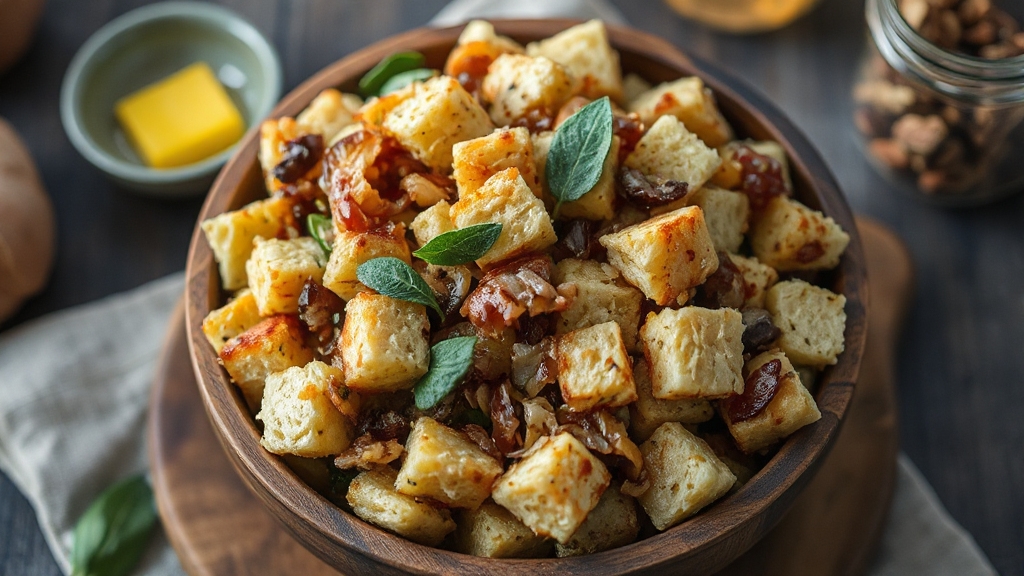
Now that your sourdough stuffing is perfectly baked, focusing on the right ingredients and small adjustments can elevate your dish even further. Choose dried sourdough cubes for tanginess or try challah or cornbread for a new twist. Fresh herbs like rosemary and thyme add depth, while sautéed onions and celery build classic flavor.
Using a digital kitchen scale ensures precise measurement of ingredients to maintain consistency. For moisture, balance butter and broth, and consider vegan alternatives if needed. Preparing the stuffing ahead of time and refrigerating it overnight helps enhance flavor and texture. Experiment with variations like sausage and apple or roasted vegetables to customize your stuffing.
Frequently Asked Questions
Can I Make Sourdough Stuffing Ahead and Freeze It?
Yes, you can make sourdough stuffing ahead and freeze it. Prepare the stuffing fully but don’t bake it. Wrap it tightly in plastic wrap and place it in a metal pan to avoid thermal shock. Freeze it unbaked, then bake it directly from frozen at 350°F for about 40 minutes covered, followed by 15-20 minutes uncovered to crisp.
This method preserves texture and flavor perfectly for up to three months.
What Is the Best Sourdough Bread Type for Stuffing?
You want artisan sourdough bread with a crusty exterior and soft, airy crumb for the best stuffing texture. Choose a boule or round loaf for easy cubing and even drying.
Whole wheat sourdough adds nuttiness and depth if you prefer heartier flavor. Avoid overly dense or moist breads, as they’ll make your stuffing soggy.
Opt for fresh or day-old bread from local bakeries to guarantee authentic flavor and texture.
How Do I Reheat Leftover Sourdough Stuffing Without Drying It Out?
To reheat leftover sourdough stuffing without drying it out, first bring it to room temperature.
Add a splash of broth or chicken stock for moisture.
Cover the stuffing with foil if using the oven at 350°F, baking for 30-40 minutes, removing foil near the end to crisp the top.
For stovetop, heat gently with a bit of butter or oil, stirring occasionally.
In the microwave, cover with a damp paper towel, heating in short intervals.
Can Sourdough Stuffing Be Made Gluten-Free?
Yes, you can make sourdough stuffing gluten-free by using gluten-free sourdough bread as your base. Slice and dry the bread cubes thoroughly before toasting them with butter or a substitute.
Combine with gluten-free broth, fresh herbs, and sautéed vegetables. For a vegan or dairy-free option, swap in plant-based butter and broth.
This way, you’ll enjoy traditional stuffing flavors without gluten, maintaining texture and taste perfectly.
What Side Dishes Pair Best With Sourdough Stuffing?
Imagine your plate as a symphony of flavors—roasted turkey’s juicy notes harmonize perfectly with creamy mashed potatoes draped in rich gravy. Brighten your meal with tart cranberry sauce and crisp green bean casserole for texture contrast.
Add roasted Brussels sprouts with balsamic glaze for a caramelized edge, and finish with buttery dinner rolls. These sides balance sourdough stuffing’s tangy richness, creating a well-rounded, unforgettable holiday feast you’ll love.
From Humble to Heavenly—Your Stuffing Steals the Show
Now that you’ve crafted your sourdough stuffing, you’re ready to bring a touch of comfort and warmth to your table. As the golden crust forms and the savory aroma fills your kitchen, remember that this dish is more than just a side—it’s a gentle hug in every bite.
With these simple steps, you’ve transformed humble ingredients into a timeless classic that will quietly steal the spotlight at any meal.

